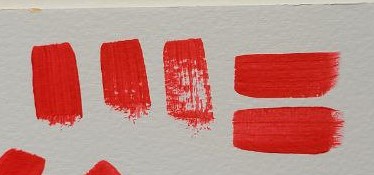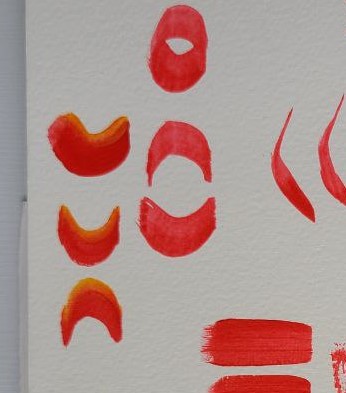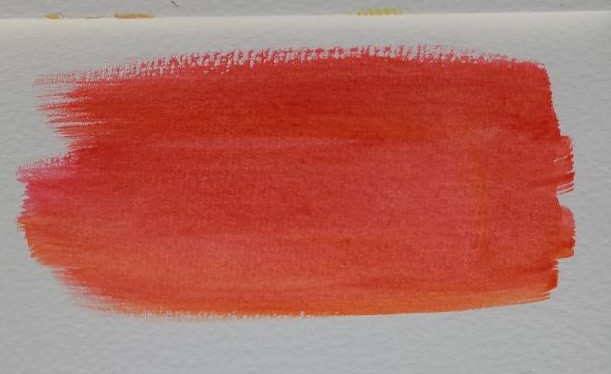Last Updated on May 16, 2024 by Masha Eretnova
If you are just starting painting, don’t be intimidated by all the different shapes and sizes of paintbrushes.
You can easily do a lot with a simple flat brush. Let me show you 9 basic brushstrokes you can do with a flat brush of any size – I use a size 6 flat brush – in your painting.
Common strokes you can do with a flat brush: lines (and hatching), wide strokes, S-shaped strokes, U-shaped strokes, straight and curved Leaf-shaped strokes (also called Comma strokes), one-stroke paintings (petals of all sorts, leaves, etc).
Flat brushes are also perfect for blending and washes.

You need:
- 2 paint colors (I used red and yellow)
- Flat brush (size 4, 6 or 8)
- Water
- Paper (can be even simple print paper)
Optional: print brushstroke worksheets to follow along with the video demonstration of brush techniques.
More: Best Brushes for Acrylic Paint on Canvas: Complete Guide
How to Use a Flat Brush
These brush techniques are useful no matter what brush size you have and what painting idea you have they’re just basic brush strokes that you can use even if you are a beginner.
The flat brush has a chisel tip and a wide brush belly. And in painting, we can use both.
Mastering your brushwork is, probably, fundamental to moving on to more complex painting techniques.
Brush strokes to practice with a flat brush:
1. Lines
Use only the tip on the brush, hold the brush vertically, and make thin lines.

2. Wide stroke

To make wide brushstrokes with a flat brush we are using the body of the brush, the belly.
You can use a wet or dry brush depending on the effect you want.
3. Wide comma (leaves, petals)

Stand on the tip of the brush and then you drag it like in a semicircle applying some pressure, and then you lift it again leaving only the tip of the brush touching the paper.
4. Thin comma

To make thinner petals or leaves, you can turn your brush and use the narrow side. This brush technique is more challenging in the beginning but when you get used to it and you’re try a few commas, it becomes easier.
5. U-shape stroke

Set the brush on the narrow side and pull it like an arch and go back to the narrow side and we can do the same but upside down.
Another way of making a U-shaped brush stroke with a flat brush and cleaner edges is to first set up the beginning and the end of the U-letter and then simply connect the two.
Using a U-shape stroke you can make nice cylinders, flower centers, or any circular/cylindric shapes.
6. S-shaped brushstroke

S-shape is by far the easiest and most fun flat brush use I know!
But switching the S from left to right is sometimes challenging to the brain haha.
Set the tip of your brush on paper, drag it like you making the letter S, press harder in the middle, and then go back to the narrow side. Tip-curve-belly-curve-tip.
7. Wash
The flat brush is perfect for blending, washes, and underpaintings.

8. One-stroke brush technique
We can load two colors on the same brush for one brush stroke (one corner with first color and another corner with the second color).
You can experiment with waves, petals, and leaves of all shapes.

9. Hard edges
A simple use for a flat brush is to fill geometrical shapes and create hard edges. The tip is perfect for making clean lines.

Print the worksheets and practice all of these brushstrokes and I hope it helps in your painting!
If you have any questions, please leave a comment and I will be happy to share what I know.
If you have a better use for a flat brush, I’m also all ears – always good to learn!

Masha Eretnova, born in 1991, is a Buenos Aires-based certified teacher, artist, and member of the Professional Artist Association with 20+ years of personal painting journey.
She started painting and drawing very early and is now an international abstract artist and educator passionate about acrylic painting, gouache, and crafts.
Her works are part of international exhibitions and contests, including ArtlyMix (Brazil), Al-Tiba 9 (Spain), Exhibizone (Canada), Italy, and many more.
Besides her artistic pursuits, Masha holds a post-grad diploma in Teaching Film Photography and 2 music school diplomas: piano and opera singing.